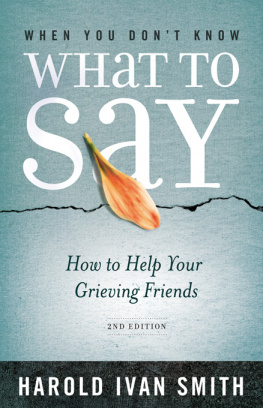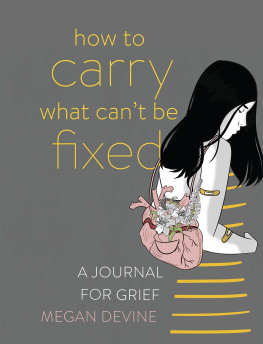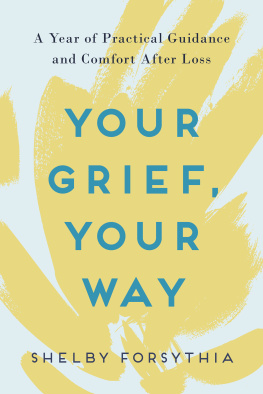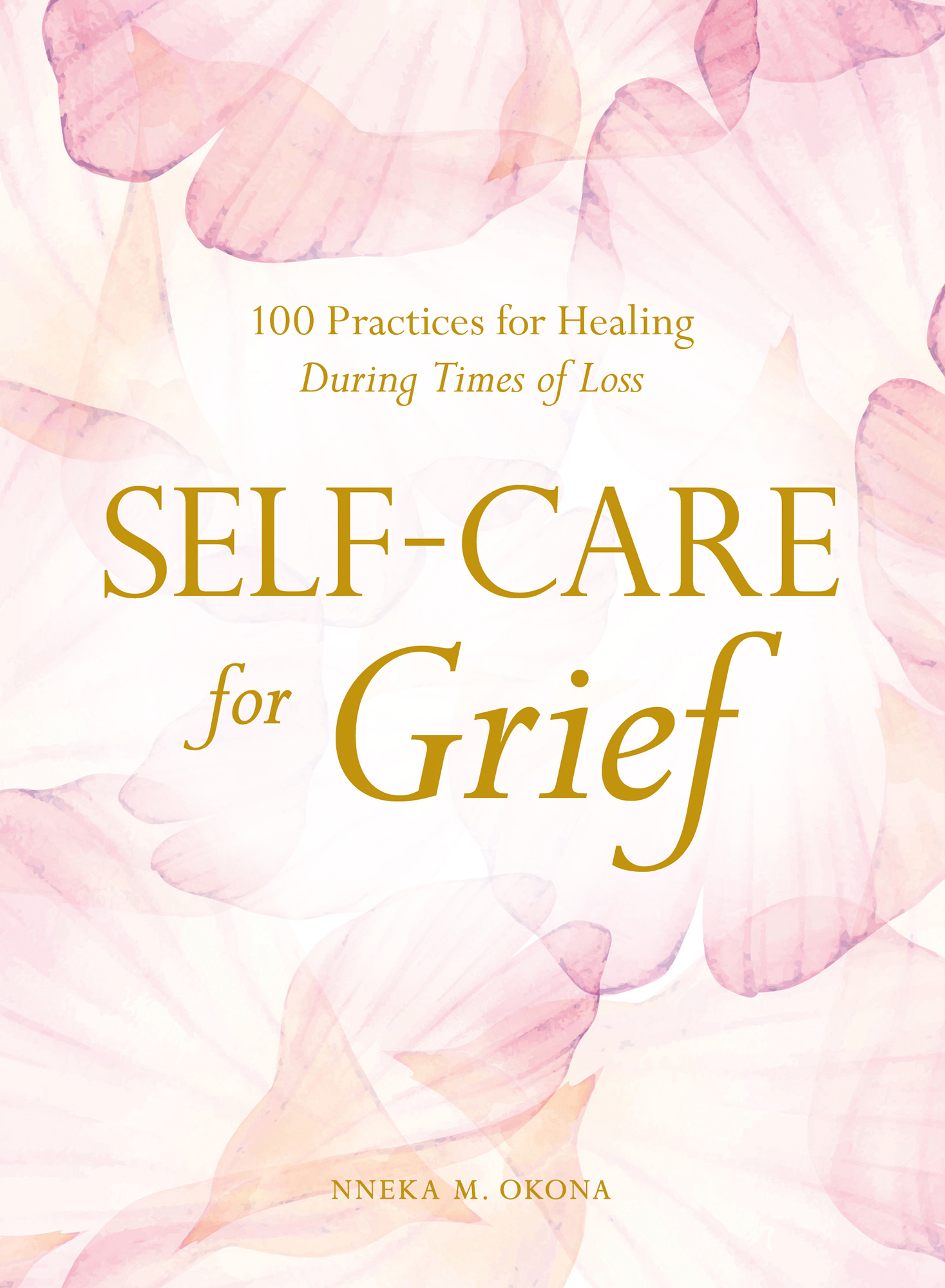Contents
Guide
100 Practices for Healing During Times of Loss
Self-Care for Grief
Nneka M. Okona
DEDICATION
To my dear friend Precious C. Williams and my Aunt Francesca Nneka Okona-Kalu: May the memory of you both continue to inspire us and guide us as we live. And to all who have grieved, and all who have lost: May you find hope, comfort, ease, validation, and softness within these pages to move forward and rebuild.

INTRODUCTION
All of us encounter grief at some point in our lives. This grief might come from the loss of a loved one, a dream that must be let go of, a career path that is no more, a big move far from the community youve cultivated, a relationship that has run its course, or routines disrupted by unforeseen circumstances. There are countless ways to grieve, and no ones experience is the same. But one thing that is always true, no matter the type of loss, is that it changes you. Grief rattles you to your core. And self-caregiving yourself the things you need physically, emotionally, mentally, and spirituallycan serve as a vital lifeline during these difficult times.
Self-Care for Grief serves as a tool for peering within and discovering what it is you need in order to heal and move forward from your own grief. Youll find self-care suggestions for your physical, emotional, mental, and spiritual wellness. Youll:
- Tune in to the wisdom of your body
- Enlist emotional support
- Plan a vacation from grief
- Create a goodbye ritual
- And more
Some activities are step-by-step guides. Others are less prescriptive and give you room to make them your own. These activities also act as a springboard for exploring and discovering what self-care will look like for you in totality. If youve never explored self-care before, expect that incorporating it into your life will be fully transformative and incredibly healing. The chapters that follow dive deeper into both grief and self-care, so you can make the most of this transformation.
Throughout this book, take what resonates and build toward a more nourishing life. Honor your grief at every turn of the page. Accept that it existsthat it is here, and that it has changed your life forever. And that better is coming.
PART ONE A Framework for Grief and Self-Care
If youre reading this book now, taking in these words, grief is known to you. Maybe youre reflecting on past losses that have become fresh in recent days, weeks, or months. Or perhaps the rawness of a loss has newly entered your life, and youre trying to find a way to deal with the immediate painto just cope in the meantime. Youre in the right place.
In the chapters that follow, youll find deeper grounding on the topics of grief and self-care. In Chapter 1, the different forms of grief are discussed, along with cultural norms and rituals for grieving, ways that grief can show up in your life, and how some people get stuck in their journey through grief. Chapter 2 is all about self-care, including its historical framework and what self-care is and isnt. Youll also find an overview of the four main types of self-care to help guide you in the activities and healing work that will come in Part 2. Go slow with these opening chapters. Let yourself have time to digest what youre reading. Divide your reading into chunks, if thats easier, versus reading it through in one go. Settle in; ready yourself for the healing that is ahead.

Chapter One Understanding Grief
Loss touches every person on this earth in its various forms. It is an inevitabilityan often unexpected upheaval that shakes up our world and demands we reintegrate the version of reality we formerly knew into a new version. In this shift one thing is made clear: There is nothing predictable whatsoever about loss and the grief that follows. And there are often certain losses that bring us to our knees, forcing us to wrestle with losing love, hope, and/or certainty in their wake. Grief happens when someone we love passes, of course, but it also happens when we lose a long-held dream or a friendship; it can be the result of a job loss, or even when we move away from a place we called home. These are all losses. And they can all encompass grief.
In this chapter, youll delve into grief more deeply. Youll explore how it can look, what holding griefand rituals to commemorate itmay include, as well as how grief can impact you moving forward, and different cultural traditions for honoring grief. There may be no other topic as complex as grief, but this chapter lays the groundwork for your own understanding as you navigate through the rest of this book and use self-care as a means of examining, holding, accepting, and healing your grief.
How Grief Looks
To know grief, to experience it, is to know a multitude of things. Multiple things are indeed true when it comes to grief. Grief is sadness. Grief is unbridled rage. Grief is disbelief and the inability to accept a loss that has shattered and forever altered your life. Grief is cycling through acceptance of what youve been handed, and being stunned at its impact over and over again until youre exhausted by the emotional rollercoaster ride. Grief is making on-the-fly adjustments as you grapple with loss and a new reality. Grief entails mental and emotional shifts.
Grief is all of these things and none of these things at the same time. That is because grief is an individualized experience. It doesnt look one specific way, and it doesnt feel the same for everyone. Though it would help to simplify things, there will never be one core expression of grief and loss. As diverse and varied as your life experiences are, your grief will be too. And how you hold that grief, and how it manifests for you personally, is varied as well.
Holding Grief
The first ninety days of teetering through grief are often touted as early grief: days when those who are grieving find themselves encountering many numbing new truths. Early grief is disorienting and is best compared to ambling through a fog. Cognitive abilities are dimmed. Mental processing takes longer than normal.
Early grief follows certain norms for what it means to grieve and hold grief, especially for those bereaving the death of loved ones. Funerals, memorial services, candlelight vigils, and the like exist as ways to commemorate our loss when it comes to death. We gather in community with those who are grieving with us, because it is in community that we have support, and together we can relish the love of those we have lost. The grief that follows those early days is no less profound or searing, of course. The earliest manifestations are simply of note because they mark an abrupt transition into an unknown: life after loss and all it may entail.
Despite these common support practices and memorials, holding grief can take us on a twisted road of emotions, thoughts, and actions. And often we may feel rushed to fully accept our loss and to move on as quickly as possible. Those feelings can come from pressure we put on ourselves, messages we interpret from those around us, or from societal and cultural expectations (more on this later). So, pressures, messages, and expectations aside for a moment, how do you hold your grief in healthy, healing ways?












